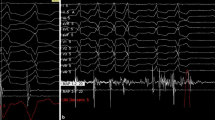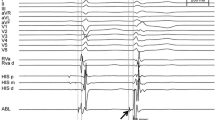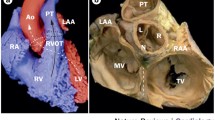Abstract
Idiopathic ventricular arrhythmias occur in patients without structural heart disease. They can arise from a variety of specific areas within both ventricles and in the supravalvular regions of the great arteries. Two main groups need to be differentiated: arrhythmias from the outflow tract (OT) region and idiopathic left ventricular, so-called fascicular, tachycardias (ILVTs). OT tachycardia typically originates in the right ventricular OT, but may also occur in the left ventricular OT, particularly in the sinuses of Valsalva or the anterior epicardium or the great cardiac vein. Activation mapping or pace mapping for the OT regions and mapping of diastolic potentials in ILVTs are the mapping techniques that are typically used. The ablation of idiopathic ventricular arrhythmias is highly successful, associated with only rare complications. Newly recognized entities of idiopathic ventricular tachycardias are those originating in the papillary muscles and in the atrioventricular annular regions.

Similar content being viewed by others
References
Papers of particular interest, published recently, have been highlighted as: • Of importance •• Of major importance
•• Aliot EM, Stevenson WG, Almendral-Garrote JM, et al.: EHRA/HRS Expert Consensus on Catheter ablation of ventricular arrhythmias. Europace 2009, 11:771–817. This is a recent state-of-the-art review of the field of catheter ablation of VT defining indications, techniques, and outcomes of the procedure.
Grimm W, Menz V, Hoffmann J, et al.: Reversal of tachycardia induced cardiomyopathy following ablation of repetitive monomorphic right ventricular outflow tract tachycardia. Pacing Clin Electrophysiol 2001, 24:166–167.
Yarlagadda RK, Iwai S, Stein KM, et al.: Reversal of cardiomyopathy in patients with repetitive monomorphic ventricular ectopy originating from the right ventricular outflow tract. Circulation 2005, 112:1092–1097.
Varma N, Josephson ME: Therapy of “idiopathic” ventricular tachycardia. J Cardiovasc Electrophysiol 1997, 8:104–116.
•• Ho SY: Overview of cardiac anatomy relevant to catheter ablation. In Catheter Ablation of Cardiac Arrhythmias: Basic Concepts and Clinical Applications. Edited by Wilber DJ, Packer DL, Stevenson WG, et al. Malden, MA: Blackwell; 2008:8–13. This is an excellent review of the organs anatomy relevant to the electrophysiologists’ perspectives.
• Boukens BJ, Christoffels VM, Coronel R, et al.: Developmental basis for electrophysiological heterogeneity in the ventricular and outflow tract myocardium as a substrate for life-threatening ventricular arrhythmias. Circ Res 2009, 104:19–31. There are important new findings about the embryologic substrate of OT arrhythmias.
Josephson ME, Callans DJ: Using the twelve-lead electrocardiogram to localize the site of origin of ventricular tachycardia. Heart Rhythm 2005, 2:443–446.
Azegami K, Wilber DJ, Arruda M, et al.: Spatial resolution of pacemapping and activation mapping in patients with idiopathic right ventricular outflow tract tachycardia. J Cardiovasc Electrophysiol 2005, 16:823–829.
Eckardt L, Breithardt G: Catheter ablation of ventricular tachycardia. From indication to three-dimensional mapping technology. Herz 2009, 34:187–196.
Thornton AS, Jordaens LJ: Remote magnetic navigation for mapping and ablating right ventricular outflow tract tachycardia. Heart Rhythm 2006, 3:691–696.
Kühne M, Sarrazin JF, Crawford T, et al.: Radiofrequency ablation guided by mechanical termination of idiopathic ventricular arrhythmias originating in the right ventricular outflow tract. J Cardiovasc Electrophysiol 2009, 21:42–46.
Kurzidim K, Schneider HJ, Kuniss M, et al.: Cryocatheter ablation of right ventricular outflow tract tachycardia. J Cardiovasc Electrophysiol 2005, 16:366–369.
Timmermans C, Manusama R, Alzand B, et al.: Catheter-based cryoablation of postinfarction and idiopathic ventricular tachycardia: initial experience in a selected population. J Cardiovasc Electrophysiol 2009, 21:255–261.
Tanner H, Hindricks G, Schirdewahn P, et al.: Outflow tract tachycardia with R/S transition in lead V3: six different anatomic approaches for successful ablation. J Am Coll Cardiol 2005, 45:418–423.
Dalal D, Tandri H, Judge DP, et al.: Morphologic variants of familial arrhythmogenic right ventricular dysplasia/cardiomyopathy: a genetics-magnetic resonance imaging correlation study. Am Coll Cardiol 2009, 53:1289–1299.
Corrado D, Basso C, Leoni L, et al.: Three-dimensional electroanatomical voltage mapping and histologic evaluation of myocardial substrate in right ventricular outflow tract tachycardia. J Am Coll Cardiol 2008, 51:731–739.
Shimizu W: Arrhythmias originating from the right ventricular outflow tract: how to distinguish “malignant” from “benign”? Heart Rhythm 2009, 6:1507–1511.
Kumagai K, Fukuda K, Wakayama Y, et al.: Electrocardiographic characteristics of the variants of idiopathic left ventricular outflow tract ventricular tachyarrhythmias. J Cardiovasc Electrophysiol 2008, 19:495–501.
Yamada T, McElderry HT, Doppalapudi H, et al.: Idiopathic ventricular arrhythmias originating from the aortic root: prevalence, electrocardiographic and electrophysiologic characteristics, and results of radiofrequency catheter ablation. J Am Coll Cardiol 2008, 52:139–147.
Callans DJ: Catheter ablation of idiopathic ventricular tachycardia arising from the aortic root. J Cardiovasc Electrophysiol 2009, 20:969–972.
Bala R, Garcia FC, Hutchinson MD, et al.: Electrocardiographic and electrophysiologic features of ventricular arrhythmias originating from the right/left coronary cusp commissure. Heart Rhythm 2010, 7:312–322.
Lin D, Ilkhanoff L, Gerstenfeld E, et al.: Twelve-lead electrocardiographic characteristics of the aortic cusp region guided by intracardiac echocardiography and electroanatomic mapping. Heart Rhythm 2008, 5:663–669.
• Suleiman M, Asirvatham SJ: Ablation above the semilunar valves: when, why, and how? Part I. Heart Rhythm 2008, 5:1485–1492. This is a hands-on article with an excellent overview of the underlying anatomy and the approaches for catheter ablation above the aortic or pulmonary valve.
• Suleiman M, Asirvatham SJ: Ablation above the semilunar valves: when, why, and how? Part II. Heart Rhythm 2008, 5:1625–1630. This is a hands-on article with an excellent overview of the underlying anatomy and the approaches for catheter ablation above the aortic or pulmonary valve.
Yamada T, McElderry HT, Doppalapudi H, et al.: Catheter ablation of ventricular arrhythmias originating in the vicinity of the His bundle: significance of mapping the aortic sinus cusp. Heart Rhythm 2008, 5:37–42.
Tada H, Tadokoro K, Miyaji K, et al.: Idiopathic ventricular arrhythmias arising from the pulmonary artery: prevalence, characteristics, and topography of the arrhythmia origin. Heart Rhythm 2008, 5:419–426.
Sekiguchi Y, Aonuma K, Takahashi A, et al.: Electrocardiographic and electrophysiologic characteristics of ventricular tachycardia originating within the pulmonary artery. J Am Coll Cardiol 2005, 45:887–895.
Daniels DV, Lu YY, Morton JB, et al.: Idiopathic epicardial left ventricular tachycardia originating remote from the sinus of Valsalva: electrophysiological characteristics, catheter ablation, and identification from the 12-lead electrocardiogram. Circulation 2006, 113:1659–1666.
Tada H, Naito S, Ito S, et al.: Significance of two potentials for predicting successful catheter ablation from the left sinus of Valsalva for left ventricular epicardial tachycardia. Pacing Clin Electrophysiol 2004, 27:1053–1059.
• Tada H, Tadokoro K, Ito S, et al.: Idiopathic ventricular arrhythmias originating from the tricuspid annulus: prevalence, electrocardiographic characteristics, and results of radiofrequency catheter ablation. Heart Rhythm 2007, 4:7–16. This is an initial study describing prevalence, ECG characteristics, and preferential sites of the origin of tricuspid annulus VTs.
Tada H, Ito S, Naito S: Idiopathic ventricular arrhythmia arising from the mitral annulus: a distinct subgroup of idiopathic ventricular arrhythmias. J Am Coll Cardiol 2005, 45:877–886.
Kumagai K, Yamauchi Y, Takahashi A, et al.: Idiopathic left ventricular tachycardia originating from the mitral annulus. J Cardiovasc Electrophysiol 2005, 16:1029–1036.
Scheinman MM: Role of the His-Purkinje system in the genesis of cardiac arrhythmia. Heart Rhythm 2009, 6:1050–1058.
Ouyang F, Cappato R, Ernst S, et al.: Electroanatomic substrate of idiopathic left ventricular tachycardia: unidirectional block and macroreentry within the Purkinje network. Circulation 2002, 105:462–469.
Okumura K, Matsuyama K, Miyagi H, et al.: Entrainment of idiopathic ventricular tachycardia of left ventricular origin with evidence for reentry with an area of slow conduction and effect of verapamil. Am J Cardiol 1988, 62:727–732.
Tsuchiya T, Okumura K, Honda T, et al.: Significance of late diastolic potential preceding Purkinje potential in verapamil-sensitive idiopathic left ventricular tachycardia. Circulation 1999, 99:2408–2413.
Nakagawa H, Beckman KJ, McClelland JH, et al.: Radiofrequency catheter ablation of idiopathic left ventricular tachycardia guided by a Purkinje potential. Circulation 1993, 88:2607–2617.
Lai LP, Lin JL, Hwang JJ, et al.: Entrance site of the slow conduction zone of verapamil-sensitive idiopathic left ventricular tachycardia: evidence supporting macroreentry in the Purkinje system. J Cardiovasc Electrophysiol 1998, 9:184–190.
Nogami A, Naito S, Tada H: Demonstration of diastolic and presystolic Purkinje potentials as critical potentials in a macroreentry circuit of verapamil-sensitive idiopathic left ventricular tachycardia. J Am Coll Cardiol 2000, 36:811–823.
Lin D, Hsia HH, Gerstenfeld EP, et al.: Idiopathic fascicular left ventricular tachycardia: linear ablation lesion strategy for noninducible or nonsustained tachycardia. Heart Rhythm 2005, 2:934–939.
Ma FS, Ma J, Tang K, et al.: Left posterior fascicular block: a new endpoint of ablation for verapamil-sensitive idiopathic ventricular tachycardia. Chin Med J (Engl) 2006, 119:367–372.
Thornton AS, Res J, Mekel JM, et al.: Use of advanced mapping and remote magnetic navigation to ablate left ventricular fascicular tachycardia. Pacing Clin Electrophysiol 2006, 29:685–688.
Good E, Desjardins B, Jongnarangsin K, et al.: Ventricular arrhythmias originating from a papillary muscle in patients without prior infarction: a comparison with fascicular arrhythmias. Heart Rhythm 2008, 5:1530–1537.
• Yamada T, Doppalapudi H, McElderry HT, et al.: Idiopathic ventricular arrhythmias originating from the papillary muscles in the left ventricle: prevalence, electrocardiographic and electrophysiological characteristics, and results of the radiofrequency catheter ablation. J Cardiovasc Electrophysiol 2010, 21:62–69. This is an article that gives detailed information about prevalence, electrocardiographic, and electrophysiologic features of this new entity of idiopathic VTs and differentiating it from fascicular and mitral annulus VTs.
Doppalapudi H, Yamada T, McElderry HT, et al.: Ventricular tachycardia originating from the posterior papillary muscle in the left ventricle: a distinct clinical syndrome. Circ Arrhythm Electrophysiol 2008, 1:23–29.
Yamada T, McElderry HT, Okada T, et al.: Idiopathic focal ventricular arrhythmias originating from the anterior papillary muscle in the left ventricle. J Cardiovasc Electrophysiol 2009, 20:866–872.
Disclosure
Dr. Hans Kottkamp has been a consultant for Biosense Webster and St. Jude Medical. No other potential conflicts of interest relevant to this article were reported.
Author information
Authors and Affiliations
Corresponding author
Rights and permissions
About this article
Cite this article
Schreiber, D., Kottkamp, H. Ablation of Idiopathic Ventricular Tachycardia. Curr Cardiol Rep 12, 382–388 (2010). https://doi.org/10.1007/s11886-010-0121-x
Published:
Issue Date:
DOI: https://doi.org/10.1007/s11886-010-0121-x




